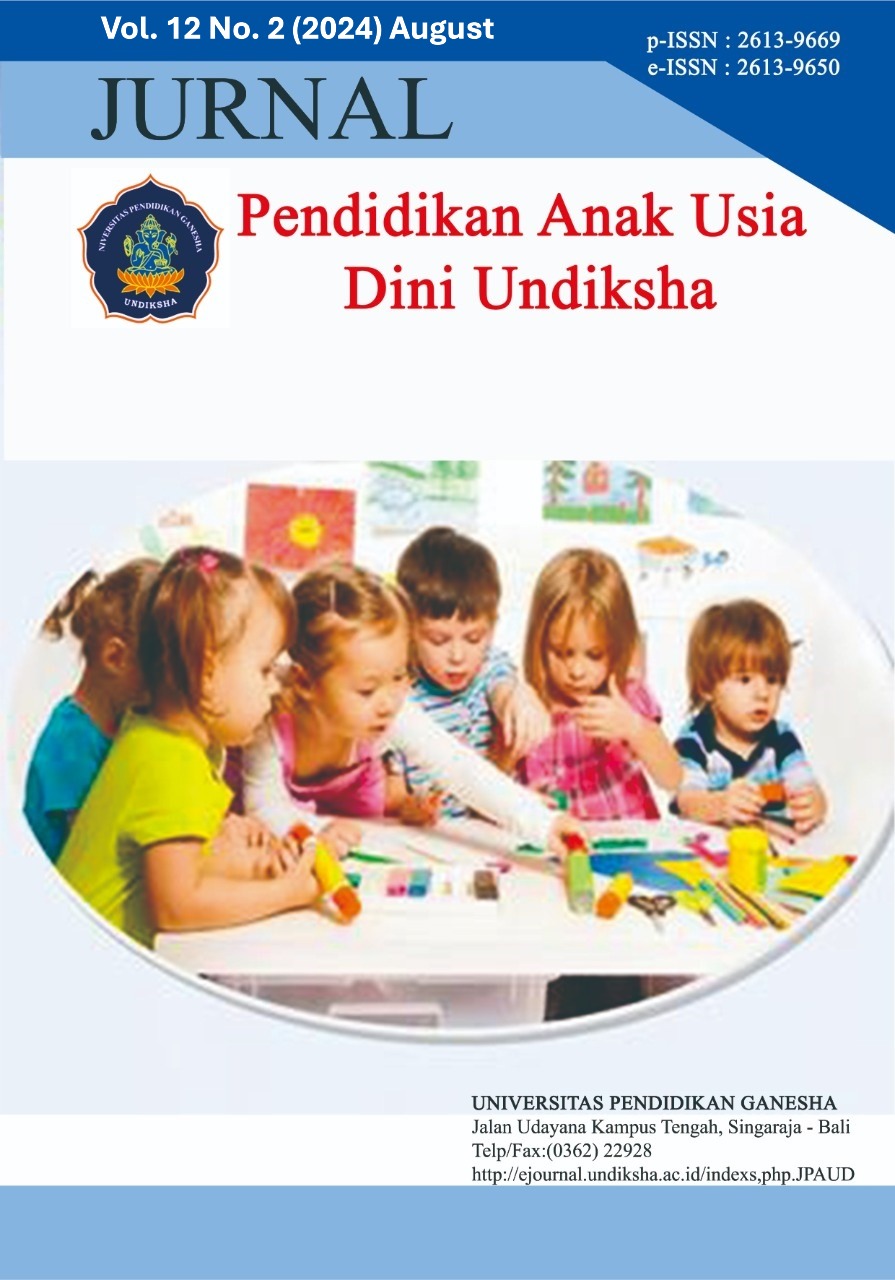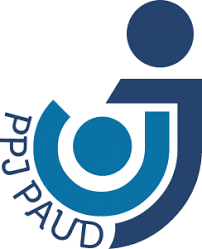Factors Influencing Receptive Language Skills in Preschoolers: The Role of Intelligence, Social Environment, and Family Background
DOI:
https://doi.org/10.23887/paud.v12i2.73630Keywords:
Receptive Language, Intelligence, Social Environment, Family BackgroundAbstract
Receptive language ability in early childhood is an important indicator of language development, influenced by various factors. However, the understanding of the factors that contribute most significantly to receptive language remains limited, warranting further investigation. This study aims to confirm the factors affecting receptive language and identify the most significant contributors to children's receptive language development. This research employs a quantitative method with an ex post facto design. The sample consists of 87 children from five kindergartens. Data were collected using a 1-5 Likert scale questionnaire and analyzed through descriptive analysis and SEM-PLS, including CFA, t-test values, p-values, and bootstrapping, using SPSS 25.0 and SmartPLS software. The results of the study indicate that the intelligence construct has a significant effect on receptive language, contributing 62.8% (t = 20.543 > 1.9; p-value = 0.00 < 0.05). The social and cultural environment construct has a significant impact on receptive language, contributing 22.5% (t = 6.707 > 1.9; p-value = 0.00 < 0.05). The family environment construct also significantly influences receptive language, contributing 25.3% (t = 6.991 > 1.9; p-value = 0.00 < 0.05). The most influential factor on receptive language is intelligence, with the highest contribution of 62.8%. The conclusion of this study is that intelligence is the primary factor influencing children's receptive language ability, followed by the social and cultural environment and the family environment.
References
Alam, S. K., & Lestari, R. H. (2019). Pengembangan kemampuan bahasa reseptif anak usia dini dalam memperkenalkan bahasa Inggris melalui flash card. Jurnal Obsesi : Jurnal Pendidikan Anak Usia Dini, 4(1), 284. https://doi.org/10.31004/obsesi.v4i1.301.
Alfin, J., & Pangastuti, R. (2020). Perkembangan Bahasa pada Anak Speechdelay. JECED: Journal of Early Childhood Education and Development, 2(1), 76–86. https://doi.org/10.15642/jeced.v2i1.572.
Almaghfiroh, Z. A., Qomariyah, G. F. A. N., Maulana, A. A., Elbarkah, A. A., & Sulaiman, H. S. (2024). Implementasi Perkembangan Bahasa dan Sosial Anak Melalui Pendidikan Orang Tua yang Berkualitas. Innovative: Journal Of Social Science Research, 4(4).
https://doi.org/10.31004/innovative.v4i4.14636.
Aminah, S. (2015). Media Panggung Boneka Terhadap Kemampuan Bercerita Anak Tunagrahita Ringan. Jurnal Pendidikan Khusus, 7(1). Retrieved from https://ejournal.unesa.ac.id/index.php/jurnal-pendidikan-khusus/article/view/10318.
Andini, A. L. (2016). Kemampuan bahasa reseptif anak kelompok A gugus V kecamatan berbah tahun 2016. Jurnal Pendidikan Anak Usia Dini, 5(6), 600–611. Retrieved from
https://journal.student.uny.ac.id/index.php/pgpaud/article/view/2589.
Annajmi, A. (2018). Kontribusi Disposisi Matematis terhadap Prestasi Belajar Matematika Siswa Kelas VIII SMPN 3 Tambusai. Edumatica: Jurnal Pendidikan Matematika, 8(1).
https://doi.org/10.22437/edumatica.v8i01.4730.
Astuti, E. (2022). Dampak Pemerolehan Bahasa Anak Dalam Berbicara Terhadap Peran Lingkungan. Educatif Journal of Education Research, 4(1), 87–96. https://doi.org/10.36654/educatif.v4i1.202.
Bitu, Y. S. (2018). Faktor-faktor yang mempengaruhi pemerolehan bahasa kedua. Jurnal Edukasi Sumba (JES), 4(3), 153–160. https://doi.org/10.53395/jes.v4i2.204.
Dewi, N. W. R., & Purandina, I. P. Y. (2022). Peran Lingkungan Keluarga Dalam Perkembangan Bahasa Anak Selama Pandemi Covid-19. Jurnal Smart Paud, 5(2). https://doi.org/10.36709/jspaud.v5i2.15.
Fitriani, N. I. (2019). Factors affecting chidren’s language development. Advance in Sosial Sciene, Education and Humanities Research, 395, 386. https://doi.org/10.14238/sp12.6.2011.386-90.
Gefen, D., Straub, D., & Boudreau, M.-C. (2000). Structural equation modeling and regression: guidelines for research practice. Communications of the Association for Information Systems, 4(7), 1–78. https://doi.org/10.17705/1cais.00407.
Hair, J. F., Hult, G. T. M., Ringle, hristian M., & Sarstedt, M. (2014). A primer on partial least quares structural equation modeling. https://doi.org/10.1016/j.lrp.2013.01.002.
Hair, J. F., Hult, G. T. M., Ringle, C. M., & Sarstedt, M. (2022). A primer on partial least squares structural equation modeling (PLS-SEM) (Third). United State of America: SAGE Publication.
Hair, J. F., Hult, G. T. M., Ringle, C. M., Sarstedt, M., Danks, N. P., & Ray, S. (2021). Partial least squares structural equation modeling (PLS-SEM) using r a qorkbook.
https://doi.org/10.1080/10705511.2022.2108813.
Hair, J. F., Hult, G. T., Ringle, C., & Sarstedt, M. (2017). A primer on partial least squares structural equation modeling (PLS-SEM) (Secod). United State of America: SAGE Publication.
Hasadikin, R., & Hernawati, T. (2018). Peningkatan kemampuan menyusun kalimat berpola SPOK melalui media kartu kata bergambar. JASSI_anakku, 19(2), 59–65.
https://doi.org/10.17509/jassi.v18i2.15448.
Hasugian, L., Ahmad, M. R., & Elyana, K. (2022). Analisis Pola Bunyi Bahasa Siswa Penyandang Down Syndrome di SLB Untung Tuah Samarinda. Adjektiva: Educational Languages and Literature Studies, 5(1), 19–24. https://doi.org/10.30872/adjektiva.v5i1.998.
Henseler, J. (2021). Composite-based structural equation modeling: analyzing latent and emergent variables. In T. D. Little (Ed.), Angewandte Chemie International Edition, 6(11), 951–952. New York London: The Guilford Press.
Hidayah, U. K., Jazeri, M., & Maunah, B. (2021). Teori Pemerolehan Bahasa Nativisme LAD. BELAJAR BAHASA: Jurnal Ilmiah Program Studi Pendidikan Bahasa Dan Sastra Indonesia, 6(2), 177–188. https://doi.org/0.32528/bb.v6i2.5539.
Juniati, R., Amal, A., & Syamsuardi, S. (2022). Chain whispering games: the effective methods of developing receptive language skills of children aged 5 - 6 years. Child Education Journal, 4(1), 13–24. https://doi.org/10.33086/cej.v4i1.2889.
Khosibah, S. A., & Dimyati. (2021). Bahasa Reseptif Anak Usia 3-6 Tahun di Indonesia. Jurnal Obsesi: Jurnal Pendidikan Anak Usia Dini, 5(2), 1860–1869. https://doi.org/10.31004/obsesi.v5i2.1015.
Lovita, I., & Ismet, S. (2021). Studi permainan bisik berantai dalam pengembangan bahasa anak usia dini. Journal of Childhood Education, 5(1), 107–116. https://doi.org/10.30736/jce.v5i1.501.
Lubis, H. Z. (2018). Metode pengembangan bahasa anak pra sekolah. Jurnal Raudhah, 06(02), 1–26. https://doi.org/10.30829/raudhah.v6i2.277.
Mailani, O., Nuraeni, I., Syakila, S. A., & Lazuardi, J. (2022). Bahasa sebagai alat komunikasi dalam kehidupan manusia. Kampret Journal, 1(2), 1–10. https://doi.org/10.35335/kampret.v1i1.8.
Marini, M., & Khasanah, K. (2018). Perkembangan Bahasa Anak Usia 12 Hingga 24 Bulan di Semarang. Journal of Studies in Early Childhood Education (J-SECE), 1(2).
https://doi.org/10.31331/sece.v1i2.625.
Maudyta, D., Aslamiah, A., & Wahdini, E. (2023). Pengaruh tingkat pendidikan dan perhatian orang tua pada pola komunikasi terhadap kemampuan berbicara anak. Jurnal Obsesi : Jurnal Pendidikan Anak Usia Dini, 7(2), 1302–1311. https://doi.org/10.31004/obsesi.v7i2.3897.
Mimin, E. (2022). Analisis Dampak Penggunaan Gadget Terhadap Aspek-Aspek Perkembangan Anak Usia Dini. Jurnal Golden Age, 6(2). Retrieved from https://e-journal.hamzanwadi.ac.id/index.php/jga/article/view/6462.
Mustika, A. (2017). Pembelajaran bahasa reseptif anak tunarungu pada anak usia dini di sekolah prima bhakti mulya. Inclusive:Journal of Special Education, 3(3), 117–121.
https://doi.org/10.30999/jse.v3i2.143.
Nadhiroh, H., & Abror, M. (2024). Penguasaan Bahasa Anak Berkebutuhan Khusus (ABK): Analisis Respons terhadap Pertanyaan di SLB Negeri Tamanwinangun Kebumen. DEIKTIS: Jurnal Pendidikan Bahasa Dan Sastra, 4(4), 1083–1093. https://doi.org/10.53769/deiktis.v4i4.1248.
Nelwati, S., & Rahman, H. K. (2022). Analisis teori jean piaget terhadap perkembangan bahasa pada anak usia sekolah dasar. Jurnal Riset Pendidikan Dasar Dan Karakter, 4(1), 13–22. Retrieved from https://ojs.adzkia.ac.id/index.php/pdk/article/view/70.
Ni’mah, N. K., Rakhmawati, D., & Septi, L. (2020). Upaya Meningkatkan Perkembangan Bahasa Dengan Media Video Pembelajaran Pada Anak Usia 5 - 6 Tahun Di TK Dharma Wanita Karangsari. Dimensi Pendidikan, 16(2), 14–28. https://doi.org/https://doi.org/10.26877/dm.v16i2.7332.
Poernomo, D. I. S. H., & Paskarinda, E. P. (2015). Faktor kesehatan, intelegensi, dan jenis kelamin mempengaruhi gangguan perkembangan bahasa anak prasekolah. Jurnal Stikes RS Baptis Kediri, 8(1), 23–33. Retrieved from https://jurnal.stikesbaptis.ac.id/index.php/STIKES/article/view/103.
Rahma, A., Nurmeiyati, Aprilia, P. D., Nuari, P. A., Rahmawadian, R., Fatmawati, R. F., & Lestari, S. A. (2022). Aspek kemampuan menyimak anak usia dini. Jurnal PAUD Emas, 1(2), 18–27. Retrieved from https://online-journal.unja.ac.id/jpe/article/download/18875/13529.
Ramadani, S., Hsb, L. A., Maharani, A., Nabillah, R., Mutmainna, S., Apriyanti, & Wahyuni, S. (2023). Perkembangan Bahasa dan Komunikasi pada Anak Tahap Awal. Al-Furqan: Jurnal Agama, Sosial, Dan Budaya, 2(6), 740–753. Retrieved from
https://publisherqu.com/index.php/Al-Furqan/article/view/737.
Rukmininggsih, Adnan, G., & Latief, M. A. (2020). Metode penelitian pendidikan (E. Munastiwi & H. Ardi, Eds.). Yogyakarta: Erhaka Utama.
Safitri, Y. (2017). Faktor-faktor yang berhubungan dengan perkembangan bahasa balita di UPTD kesehatan baserah tahun 2016. Jurnal Obsesi : Jurnal Pendidikan Anak Usia Dini, 1(2), 97–104. Retrieved from https://obsesi.or.id/index.php/obsesi/article/view/35.
Santrock, J. W. (2016). A topical approach to life span developmnet (Eigth). Amerika Serikat: Mc Grow Hill Education.
Simatupang, N. D., Widayati, S., & Adhe, K. R. (2023). Pelatihan Bercerita dengan Big Book dan Lagu untuk Meningkatkan Minat Berbahasa Anak Usia Dini. Community Development Journal: Jurnal Pengabdian Masyarakat, 4(6), 13184–13190. https://doi.org/10.31004/cdj.v4i6.18166.
Sugiyono. (2015). Metode Penelitian Kuantitatif Kualitatif dan R&D. Bandung: Alfabeta.
Suhadi, & Istanti. (2019). Faktor-faktor yang berhubungan dengan tingkat keterlambatan bicara dan bahasa pada anak usia 2-5 tahun. Jurnal Penelitian Perawat Profesional, 2(2), 227–234.
https://doi.org/10.37287/jppp.v2i2.115.
Sukat, Putriyanti, L., & Sulianto, J. (2024). Analisis Perkembangan Bahasa dan Pemerolehan Bahasa Anak Usia Dini. Didaktik: Jurnal Ilmiah PGSD STKIP Subang, 10(2), 568–578.
https://doi.org/10.36989/didaktik.v10i2.3152.
Sumaryanti, L. (2017). Peran lingkungan terhadap perkembangan bahasa anak. MUADDIB, 07(01), 72–89. Retrieved from https://journal.umpo.ac.id/index.php/muaddib/article/download/552/475.
Sundari, W. (2018). Pemerolehan Bahasa. Jurnal Warna, 2(1), 54–75. Retrieved from
http://download.garuda.kemdikbud.go.id/article.php?article=907933&val=14298&title=PEMEROLEHAN BAHASA.
Uce, L. (2017). The golden age: Masa efektif merancang kualitas anak. Bunayya: Jurnal Pendidikan Anak, 1(2), 77–92. Retrieved from https://jurnal.ar-raniry.ac.id/index.php/bunayya/article/viewFile/1322/982.
Yulianda, A. (2019). Faktor-faktor yang mempengaruhi keterlambatan berbicara berbicara pada anak balita. Jurnal Pendidikan Bahasa Dan Sastra Indonesia, 3(2), 12–16.
Downloads
Published
How to Cite
Issue
Section
License
Copyright (c) 2024 Shofia Hikmatuzzohrah, Amir Syamsudin, Ika Budi Maryatun

This work is licensed under a Creative Commons Attribution-ShareAlike 4.0 International License.
Authors who publish with the Jurnal Pendidikan Anak Usia Dini Undiksha agree to the following terms:
- Authors retain copyright and grant the journal the right of first publication with the work simultaneously licensed under a Creative Commons Attribution License (CC BY-SA 4.0) that allows others to share the work with an acknowledgment of the work's authorship and initial publication in this journal.
- Authors are able to enter into separate, additional contractual arrangements for the non-exclusive distribution of the journal's published version of the work (e.g., post it to an institutional repository or publish it in a book), with an acknowledgment of its initial publication in this journal.
- Authors are permitted and encouraged to post their work online (e.g., in institutional repositories or on their website) prior to and during the submission process, as it can lead to productive exchanges, as well as earlier and greater citation of published work. (See The Effect of Open Access)











